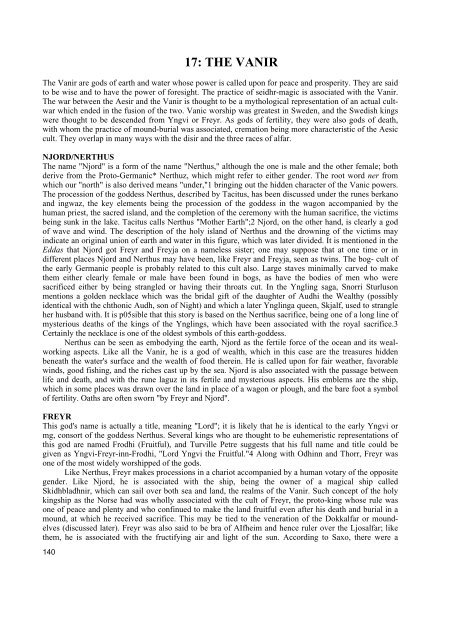TEUTONIC MAGIC - Awaken Video
TEUTONIC MAGIC - Awaken Video
TEUTONIC MAGIC - Awaken Video
Create successful ePaper yourself
Turn your PDF publications into a flip-book with our unique Google optimized e-Paper software.
17: THE VANIR<br />
The Vanir are gods of earth and water whose power is called upon for peace and prosperity. They are said<br />
to be wise and to have the power of foresight. The practice of seidhr-magic is associated with the Vanir.<br />
The war between the Aesir and the Vanir is thought to be a mythological representation of an actual cultwar<br />
which ended in the fusion of the two. Vanic worship was greatest in Sweden, and the Swedish kings<br />
were thought to be descended from Yngvi or Freyr. As gods of fertility, they were also gods of death,<br />
with whom the practice of mound-burial was associated, cremation being more characteristic of the Aesic<br />
cult. They overlap in many ways with the disir and the three races of alfar.<br />
NJORD/NERTHUS<br />
The name "Njord" is a form of the name "Nerthus," although the one is male and the other female; both<br />
derive from the Proto-Germanic* Nerthuz, which might refer to either gender. The root word ner from<br />
which our "north" is also derived means "under,"1 bringing out the hidden character of the Vanic powers.<br />
The procession of the goddess Nerthus, described by Tacitus, has been discussed under the runes berkano<br />
and ingwaz, the key elements being the procession of the goddess in the wagon accompanied by the<br />
human priest, the sacred island, and the completion of the ceremony with the human sacrifice, the victims<br />
being sunk in the lake. Tacitus calls Nerthus "Mother Earth";2 Njord, on the other hand, is clearly a god<br />
of wave and wind. The description of the holy island of Nerthus and the drowning of the victims may<br />
indicate an original union of earth and water in this figure, which was later divided. It is mentioned in the<br />
Eddas that Njord got Freyr and Freyja on a nameless sister; one may suppose that at one time or in<br />
different places Njord and Nerthus may have been, like Freyr and Freyja, seen as twins. The bog- cult of<br />
the early Germanic people is probably related to this cult also. Large staves minimally carved to make<br />
them either clearly female or male have been found in bogs, as have the bodies of men who were<br />
sacrificed either by being strangled or having their throats cut. In the Yngling saga, Snorri Sturluson<br />
mentions a golden necklace which was the bridal gift of the daughter of Audhi the Wealthy (possibly<br />
identical with the chthonic Audh, son of Night) and which a later Ynglinga queen, Skjalf, used to strangle<br />
her husband with. It is p05sible that this story is based on the Nerthus sacrifice, being one of a long line of<br />
mysterious deaths of the kings of the Ynglings, which have been associated with the royal sacrifice.3<br />
Certainly the necklace is one of the oldest symbols of this earth-goddess.<br />
Nerthus can be seen as embodying the earth, Njord as the fertile force of the ocean and its wealworking<br />
aspects. Like all the Vanir, he is a god of wealth, which in this case are the treasures hidden<br />
beneath the water's surface and the wealth of food therein. He is called upon for fair weather, favorable<br />
winds, good fishing, and the riches cast up by the sea. Njord is also associated with the passage between<br />
life and death, and with the rune laguz in its fertile and mysterious aspects. His emblems are the ship,<br />
which in some places was drawn over the land in place of a wagon or plough, and the bare foot a symbol<br />
of fertility. Oaths are often sworn "by Freyr and Njord".<br />
FREYR<br />
This god's name is actually a title, meaning "Lord"; it is likely that he is identical to the early Yngvi or<br />
mg, consort of the goddess Nerthus. Several kings who are thought to be euhemeristic representations of<br />
this god are named Frodhi (Fruitful), and Turville Petre suggests that his full name and title could be<br />
given as Yngvi-Freyr-inn-Frodhi, "Lord Yngvi the Fruitful."4 Along with Odhinn and Thorr, Freyr was<br />
one of the most widely worshipped of the gods.<br />
Like Nerthus, Freyr makes processions in a chariot accompanied by a human votary of the opposite<br />
gender. Like Njord, he is associated with the ship, being the owner of a magical ship called<br />
Skidhbladhnir, which can sail over both sea and land, the realms of the Vanir. Such concept of the holy<br />
kingship as the Norse had was wholly associated with the cult of Freyr, the proto-king whose rule was<br />
one of peace and plenty and who confinued to make the land fruitful even after his death and burial in a<br />
mound, at which he received sacrifice. This may be tied to the veneration of the Dokkalfar or moundelves<br />
(discussed later). Freyr was also said to be bra of AIfheim and hence ruler over the Ljosalfar; like<br />
them, he is associated with the fructifying air and light of the sun. According to Saxo, there were a<br />
140
















